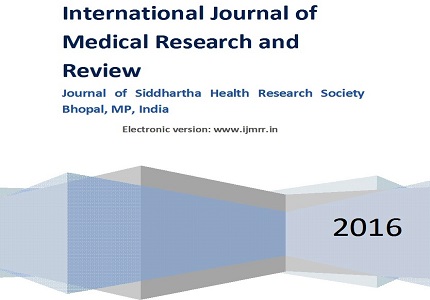Recurrent rheumaticactivity in rheumatic heart disease
Abstract
Introduction: Acute rheumatic fever (ARF) is caused by autoimmune effect of group A streptococcal infection (GAS). Cardiac involvement is typically pancarditis. Valvular damage persists after the improvement of acute episode of ARF, the persistent valvular defect and its sequel is called rheumatic heart disease (RHD). People with previous episode of ARF are at increased risk of developing newer episodes of ARF and it increases the severity of valvular damage. Thus RHD gradually worsens in patients with recurrent attacks of ARF. Frequent episodes of ARF can be prevented by secondary prophylaxis.
Methods and Materials: All diagnosed cases of RHD were includedand non RHD patients were excluded from this study. Proper history, detailed physical examination, routine laboratory test, ECG and echocardiography were done in all patients. Recurrent rheumatic activity was diagnosed on the basis of modified Jones criteria’1992 and who criteria of 2004.
Results: Among 100 patients studied, 45 cases were hospitalised because of heart failure due to poor compliance of medications, 38 had acute attack of rheumatic fever, and 17 cases were having lower respiratory tract infection. Thus the incidence of acute rheumatic activity in established RHD was 38%. 50% patients were on penicillin prophylaxis and 10% were on oral tablets of penicillin or azithromycin for secondary prophylaxis. It means 60% of the patient population was on secondary prophylaxis.
Conclusion: Recurrent rheumatic activity is a hidden cause of morbidity and mortality in established cases of RHD as penicillin prophylaxis is not adequate because of poor compliance to the drug.
Downloads
References
2. Carapetis JR, Steer AC, Mulholland EK, Weber M.The global burden of group A streptococcal diseases.Lancet Infect Dis. 2005 Nov; 5(11):685-94. [PubMed]
3. Guilherme L, Cury P, Demarchi LM, Coelho V, Abel L, Lopez AP, Oshiro SE, Aliotti S, Cunha-Neto E, Pomerantzeff PM, Tanaka AC, Kalil J.Rheumatic heart disease: proinflammatory cytokines play a role in the progression and maintenance of valvularlesions.Am J Pathol. 2004 Nov; 165(5):1583-91. [PubMed]
4. Guidelines for the diagnosis of rheumatic fever. Jones criteria, 1992 update. Special Writing Group of the Committee on Rheumatic Fever Endocarditis and Kawasaki Disease of the Council on Cardiovascular Disease in the Young of the American Heart Association. JAMA 1992 Oct 21; 268(15): 2069-73. [PubMed]
5. Smith MT, Zurynski Y, Lester-Smith D, Elliott E, Carapetis J.Rheumatic fever - identification, management and secondary prevention.AustFam Physician. 2012 Jan-Feb; 41(1-2):31-5. [PubMed]
6. Rheumatic fever and rheumatic heart disease. Report of a WHO Study Group.World Health Organ Tech Rep Ser. 1988; 764:1-58. [PubMed]
7. Vijaykumar M, Narula J, Reddy KS, Kaplan EL.Incidence of rheumatic fever and prevalence of rheumatic heart disease in India.Int J Cardiol. 1994 Mar 1; 43(3):221-8. [PubMed]
8. Padmavati S.Rheumatic fever and rheumatic heart disease in developing countries.Bull World Health Organ. 1978; 56(4):543-50. [PubMed]
9. Diagnosis and management of acute rheumatic fever; Chapter 3, The Australian guideline for prevention, diagnosis and management of acute rheumatic fever and rheumatic heart disease (2nd edition), 2012.
10. Carvalho SM, Dalben I, Corrente JE, Magalhães CS.Rheumatic fever presentation and outcome: a case-series report.Rev Bras Reumatol. 2012 Mar-Apr; 52(2):241-6. [PubMed]
11. Meira ZM, Goulart EM, Colosimo EA, Mota CC.Long term follow up of rheumatic fever and predictors of severe rheumatic valvar disease in Brazilian childrenand adolescents.Heart. 2005 Aug;91(8):1019-22.
12. Beggs S et al; Antibiotic use for the Prevention and Treatment of Rheumatic Fever and Rheumatic Heart Disease in Children, WHO, 2008 June 30.
13. Manyemba J, Mayosi BM.Penicillin for secondary prevention of rheumatic fever.Cochrane Database Syst Rev. 2002 ;( 3):CD002227. Penicillin for secondary prevention of rheumatic fever. [PubMed]
14. Dajani AS. Adherence to physicians' instructions as a factor in managing streptococcal pharyngitis.Pediatrics. 1996 Jun; 97(6Pt 2):976-80.



 OAI - Open Archives Initiative
OAI - Open Archives Initiative


